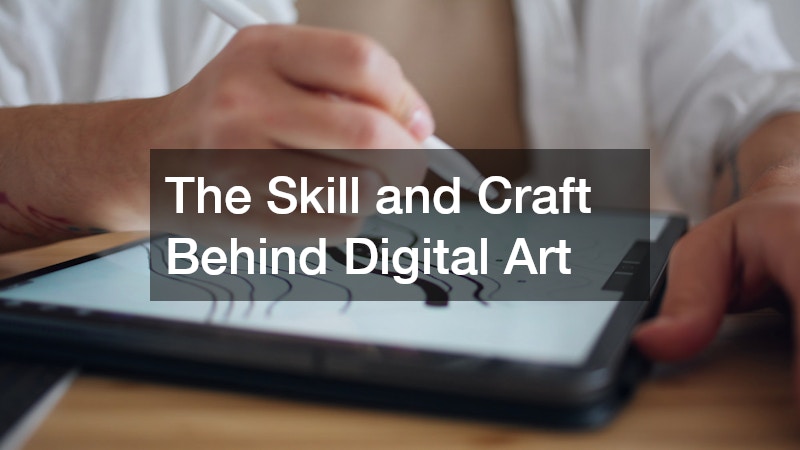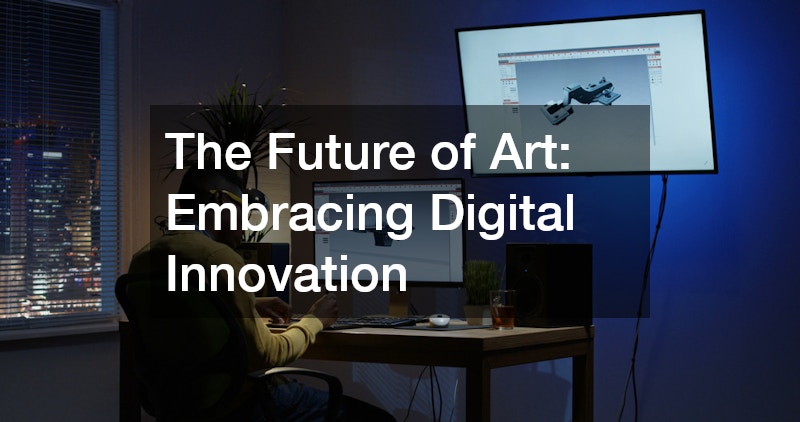In the ever-evolving landscape of art, the emergence of digital mediums has sparked a vibrant debate: Is digital art real art? This question resonates deeply within artistic communities, especially among artists and enthusiasts navigating the intersection of tradition and technology. As digital tools become increasingly sophisticated, they offer artists new avenues for expression, challenging conventional notions of artistry and authenticity.
This article aims to delve into the heart of this debate, exploring the myths surrounding digital art and celebrating the creativity it fosters. By examining the skills involved, the emotional depth conveyed, and the evolving perceptions within the art world, we seek to affirm the legitimacy of digital art as a true and valuable form of artistic expression.
Understanding the Skepticism: Why Some Question Digital Art’s Legitimacy
Despite the growing prevalence of digital art, skepticism persists regarding its authenticity. Critics often argue that digital art lacks the tangible qualities of traditional media, suggesting that the ease of use and availability of digital tools diminish the skill required. Traditional art forms, like painting and sculpture, have long been associated with a sense of craftsmanship and physical presence, which digital art lacks at first glance. The tactile experience of applying brushstrokes to canvas or chiseling a piece of marble offers an intimate connection between the artist and their medium that some critics feel digital art cannot replicate.
However, this perspective overlooks the complexity and discipline involved in digital creation. Mastery of digital art demands a deep understanding of traditional artistic principles, such as composition, color theory, and perspective, applied through digital interfaces. The tools may differ, but the foundational skills remain consistent. Moreover, digital artists must have an intricate knowledge of software, hardware, and digital techniques to produce work that is comparable in quality to traditional forms. The assertion that digital art is “easier” fails to recognize the high level of expertise and patience required to master these digital tools. Just as traditional artists spend years honing their craft, digital artists invest significant time and effort to achieve proficiency, demonstrating that skill is essential in both realms.
The Skill and Craft Behind Digital Art

Digital art is not merely the product of software; it is the culmination of an artist’s vision, skill, and dedication. While the medium might be digital, the process remains remarkably similar to traditional artistic methods. Digital artists start with conceptualization—developing ideas and themes, just as a painter might sketch or plan their artwork. This phase is crucial, as it sets the foundation for the entire piece. Like their traditional counterparts, digital artists rely on an intimate understanding of design principles, such as symmetry, proportion, and harmony. It is this mastery of design that separates good digital art from great digital art.
Once the initial concept is established, digital artists then move on to sketching and composition. These sketches, often completed using a stylus and tablet, may begin as rough outlines, with further layers and details gradually being added. One advantage of digital art tools is their flexibility—artists can experiment with different elements without committing to a single direction. As in traditional media, decisions around color, lighting, and texture play a key role in transforming a simple idea into a completed work of art.
Additionally, the proficiency required to master advanced software tools like Adobe Photoshop, Illustrator, or Procreate cannot be underestimated. These tools allow artists to refine their work with intricate detail and precision. For example, digital painters use layers, brushes, and textures to create depth, which requires both technical knowledge and artistic instinct. Whether creating 3D models, digital paintings, or animations, these tools enable an exceptional level of control that mirrors traditional techniques but in a virtual space.
Emotional Depth and Expression in Digital Art
Art, at its core, is a medium for emotional expression and storytelling. Digital art is no exception. In fact, many digital artists leverage the unique capabilities of their medium to explore and convey emotions in innovative ways. For instance, digital illustrations can capture the nuances of human emotion, while digital paintings can evoke moods through color palettes, lighting, and visual texture. The ability to manipulate and experiment with various artistic elements offers digital artists an exciting freedom to express themselves in new and often unexpected ways.
In digital art, emotions are not confined to brushstrokes or physical textures. Rather, artists can craft entire worlds and narratives, with complex layers of meaning that engage viewers on a deeper emotional level. This is particularly evident in digital art genres such as concept art, where the mood and atmosphere are integral to the story being told. For example, in the world of video games, concept art helps set the emotional tone of the game, guiding the player’s experience through visual cues and environmental design.
Furthermore, digital art allows for accessibility and innovation in storytelling. Artists are not limited by the constraints of traditional media; they can experiment with new techniques that create more dynamic emotional expressions. Whether through glitch art, surreal imagery, or complex animations, digital art provides a platform for a diverse range of emotional experiences, from catharsis to joy, sadness to introspection. Just like traditional art, digital works evoke responses that resonate deeply with audiences, reinforcing the notion that emotional depth is universal, regardless of the medium.
The Evolution of Art: Embracing New Mediums
Art has always been a dynamic and evolving field, from the first cave paintings to the rise of abstract expressionism. New technologies have historically expanded the boundaries of artistic expression, leading to the creation of new media and genres. Photography, for example, was once considered a mechanical process devoid of artistic merit. Over time, however, it was embraced by the art world as a legitimate form of artistic expression. Similarly, digital art represents the latest step in this ongoing evolution.
As the world becomes increasingly digital, it’s only natural that the tools for creating art evolve to reflect the times. Digital art offers new avenues for innovation and expression, allowing artists to incorporate elements such as animation, interactivity, and immersive experiences into their work. The rise of virtual reality (VR) and augmented reality (AR) is already pushing the boundaries of what we consider art, further cementing digital mediums as a key aspect of modern artistic practice. Much like photography or film, digital art is carving its niche in the broader landscape of creative expression.
For artists who embrace digital tools, the ability to blend traditional techniques with cutting-edge technology opens a new realm of possibilities. Today’s digital artists are not only creating in virtual spaces but also revolutionizing the art world by presenting their work in innovative formats, including digital galleries, interactive exhibitions, and online platforms that provide greater reach and accessibility.
Addressing the “Cheating” Misconception
A common misconception is that digital art is “cheating” due to features like undo buttons, layers, and filters. These tools often lead to the belief that digital artists are merely pushing buttons, without engaging in the traditional process of physical creation. However, the reality is much more nuanced. Digital tools simply enhance the artistic process, providing artists with new means of control, experimentation, and precision. The ability to work with layers, for instance, is not unlike a traditional artist’s use of underpainting or creating preparatory sketches.
Critics who label digital art as “cheating” fail to recognize that every medium, from oil painting to sculpture, comes with its own set of tools and techniques designed to help artists achieve their creative vision. Just as a sculptor uses chisels or a painter relies on brushes and canvas, digital artists use software as their primary medium. These tools help refine their ideas, correct mistakes, and experiment freely. The “undo” feature is just one example of how technology allows for more flexibility in the creative process, offering a freedom that traditional mediums cannot.
Ultimately, the skill required to make great digital art is no less significant than that required in any other form of art. It is the vision, dedication, and craftsmanship of the artist that make digital art a true form of creative expression.
The Role of Digital Art in Contemporary Culture
Digital art plays a significant role in contemporary culture, influencing various industries and platforms. Unlike traditional art forms, which may take time to be integrated into mainstream culture, digital art has quickly established itself in areas like entertainment, advertising, and social media. In the entertainment industry, digital art is integral to the production of films, video games, and animation. These digital media often define the aesthetic of modern visual culture, from stunning visual effects in blockbuster films to character design in video games.
Additionally, digital art is increasingly used in advertising and marketing. Companies turn to digital artists to create eye-catching promotional materials, branding assets, and digital illustrations that captivate consumers. In fact, the fast-paced, visually driven nature of the digital age has made digital art an indispensable part of the marketing landscape.
The widespread presence of digital art is also evident in social media. Platforms like Instagram and DeviantArt allow digital artists to share their work with a global audience, reaching individuals who might never have encountered traditional forms of art. This accessibility fosters a more inclusive and diverse art world, where anyone can be an artist, and anyone can appreciate art.
By playing a significant role in these industries, digital art has proven itself not only as a legitimate form of artistic expression but also as a driving force in contemporary visual culture.
The Intersection of Digital Art and Traditional Techniques
Many artists today blend traditional art techniques with digital methods, creating hybrid works that combine the best of both worlds. This intersection is an exciting aspect of the modern art scene, offering fresh perspectives and new possibilities for creative expression. For instance, an artist might begin a piece with a hand-drawn sketch on paper, scan it into a computer, and then add color, texture, and digital elements using software. In this way, digital art becomes an extension of traditional techniques rather than a replacement.
Moreover, some digital artists combine the visual effects of digital tools with physical elements, such as printmaking or sculpture. These mixed-media approaches push the boundaries of both digital and traditional art, creating innovative and compelling works that challenge the conventional separation between the two.
Artists who explore this intersection are able to incorporate the tactile and organic qualities of traditional media with the versatility and precision of digital tools. This fusion opens up endless possibilities for artistic exploration, allowing artists to experiment and innovate in ways that were previously unimaginable.
The Future of Art: Embracing Digital Innovation

As technology continues to advance, digital art will play an increasingly prominent role in the art world. Emerging technologies like virtual reality (VR), augmented reality (AR), and artificial intelligence (AI) are expanding the boundaries of artistic expression. Artists are already exploring VR and AR to create immersive art experiences that engage the viewer in entirely new ways. These technologies allow artists to build virtual worlds or environments where viewers can interact with the artwork, creating dynamic, ever-changing experiences.
Additionally, AI is becoming an essential tool for digital artists, helping them generate unique designs, patterns, and even entire artworks. While some view this as a challenge to human creativity, others see AI as an opportunity to explore new creative possibilities and push the boundaries of what art can be. In the future, AI-generated art could open new avenues for collaboration between humans and machines, providing artists with innovative ways to express their ideas.
As digital tools continue to evolve, they will undoubtedly shape the future of the art world. For those willing to embrace these changes, digital art offers an exciting and dynamic platform for creative exploration, ensuring that the art world remains as diverse and relevant as ever.
Conclusion: Affirming Digital Art’s Place in the Artistic Landscape
The question, “Is digital art real art?” invites us to reflect on the essence of art itself. Art is defined not by its medium but by the creativity, skill, and intention behind it. Digital art embodies these qualities, offering a legitimate and powerful means of expression. By debunking myths and celebrating the creativity inherent in digital art, we affirm its rightful place in the artistic landscape. As artists and enthusiasts, embracing digital art enriches our understanding and appreciation of the diverse forms art can take.


